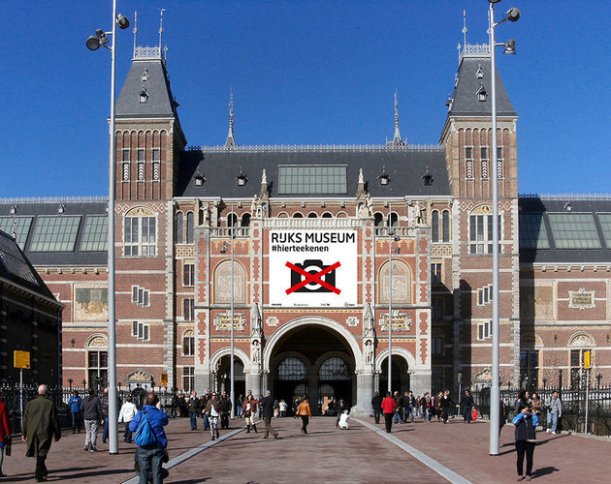The ongoing campaign at Rijksmuseum, banning photography (in a humorous way) and encouraging visitors to draw art, has caught the attention of media:
The Rijksmuseum in Amsterdam wants visitors to enjoy its collection of artwork the way it was appreciated in a pre-cellphone era, by leaving their devices and cameras at home. Through their #Startdrawing initiative, they’ve “banned” technology, encouraging people to bring their sketchbooks and draw the beautiful paintings, prints, and sculptures in front of them—as opposed to quickly recording it all on their phones.
My Modern MetRijksmuseum believes that media has devolved a visit to a museum into “a passive and superficial experience,” according to its website. “Visitors are easily distracted and do not truly experience beauty, magic and wonder. This is why the Rijksmuseum wants to help visitors discover and appreciate the beauty of art and history through drawing, so #startdrawing!
Huffington PostAn argument could be made supporting the claim that the curse of this generation is that in an effort to stay more connected, we are actually less connected than ever. As we busily doodle on our phones, we are missing the world around us and the present moment. Being so focused on our phones means we are distracted by our surrounds, by life as it passes us by.
SLR Lounge
So does this campaign achieve it’s goal? To encourage people to truly look at art? I am sure this will be a great success, by drawing attention to the art and the interaction with art. It’s a brilliant idea, in several ways. By adressing a much discussed topic of mobile phones, selfies, photography and museums, and by showing a different way of interacting with art.
However it is at the same time unfortunate to actually target people’s desire to take pictures in museums, a desire that obviously is very strong considering the amount of photos taken in museums every day. I am also afraid this will give support to anti-photography opinions.
To take pictures in museums, to walk around using the mobile phone, is one very important way of interacting with the museum. As I have looked into the Instagram photos taken by visitors at Nordiska museet it is clear that these photos are just one part of the personal Instagram feed. A feed that is in itself a narrative, the story of me.
Depending on what kind of story the visitor wants to share with his or her audience, the photographic trail from the museum visit will look very different. Some take many pictures, some take one. Some put great attention to details, tell a story with the photos and sometimes include themselves through selfies, and others just take a picture of the building.
For museums it should be of great interest to further look into the Instagram feeds of their visitors, and into the photos taken and tagged at the museum. Which objects or exhibitions catch most attention of the visitors? How does the visitor include him or herself into the narrative? For the visitor’s own narrative is perhaps the most important aspect of the museum visit. So ask yourself: How does the museum fit into it?
The only story I am consistently interested in is the story of me, the one that I am “constantly writing, rewriting, editing and conspiring about.” It’s the one story that I am constantly tuned into all the time.
Sapient Nitro, India
I think offering opportunities to interact with the museum in several different ways, like drawing the museum art, is a necessity. But don’t confuse visitors by removing their own tools for creating the story of me.

